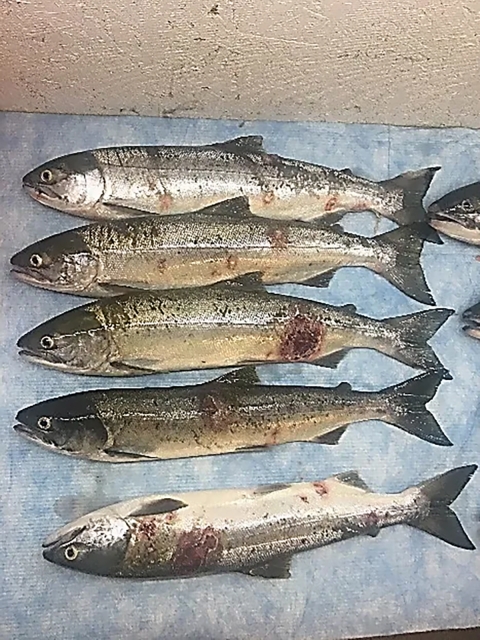Elevated water temperature across the Columbia River basin is already having an impact on migrating adult sockeye salmon.
Due to the extreme heatwave in late June, coupled with decreased snowpack in many areas, the water temperatures on the Columbia River and its tributaries are spiking to unsafe levels for migrating salmon. These returning salmon do best when water temperatures are 60 degrees or below. However, they’re already encountering water in the low 70s as they navigate upstream to spawn.
A mid-July survey of adult sockeye salmon, collected at Priest Rapids Dam by the Yakama Nation, showed that most of the fish had multiple skin lesions ranging from light abrasions of the skin to large open sores exposing muscle. These lesions differ from those typically observed in 10-plus years of Yakama Nation moving adult salmon from Priest Rapids Dam to Lake Cle Elum.
Fish health specialist David Thompson and fish health veterinarian Katie Royer, both of whom are a part of the Service’s Fish and Aquatic Conservation team in the Pacific Northwest, examined the sockeye salmon at Priest Rapids Dam.
“It was clear these lesions were not primarily from Pacific lamprey bites. It’s a warm water issue,” Thompson said. “Sockeye seem to be a little more prone to skin issues than the other species. Reports from Priest Rapids Dam was that steelhead and summer Chinook didn’t have these lesions. It could be that the sockeye are a little more susceptible to the higher temperatures than the other species going up river right now.”
This summer is showing similarities to 2015, which was the last time that comparable lesions were found in migrating salmon. That was a historically bad year for salmon.
According to NOAA Fisheries’ 2015 Adult Sockeye Salmon Passage Report, low snowpack, coupled with extremely high air temperatures throughout the interior Columbia basin, resulted in warm water in the major tributaries to the lower Snake and Columbia rivers. Losses of migrating sockeye salmon exceeded 95% in some areas.
Water temperatures have increased much more quickly than usual this year across the Columbia River basin. The Columbia River is currently above 72 degrees at Bonneville Dam, and has been above average since June 12, and situations are similar across the basin.
“Warm water causes immune system suppression in the salmon,” Thompson said. “In a normal year, fish bump into things during migration and get small skin abrasions that usually heal. When their immune systems are compromised by warm water, those lesions develop infections caused by common bacterial and fungal organisms that are found in the warmer waters. They don’t have any immune response to those diseases.”
Royer added: “There’s a Venn diagram of overlapping circles of host, pathogen and environment. Where those circles overlap, you get disease in salmon. This is just one example of one type of problem we’re going to see more and more if climate change climate change
Climate change includes both global warming driven by human-induced emissions of greenhouse gases and the resulting large-scale shifts in weather patterns. Though there have been previous periods of climatic change, since the mid-20th century humans have had an unprecedented impact on Earth's climate system and caused change on a global scale.
Learn more about climate change progresses. We’re going to see more diseases and likely fish loss.”
Thompson and Royer are part of the Service’s commitment to fish health in the Pacific Northwest. Based at Little While Salmon National Fish Hatchery, they travel throughout central Washington and Oregon to monitor the health of the salmon — adults and juveniles — at the National Fish Hatcheries that produce millions of young salmon.
“We basically go to hatcheries to see the health status of fish at each hatchery,” Thompson said. “If there’s anything wrong, we help troubleshoot it with the hatchery staff to see what the issues are. If there’s high mortality or if they’re just not growing right, we help with that too. We sometimes send samples to outside labs, and based on what we find and what the lab finds, we consult with the hatchery staff to come up with best treatment protocols.”
There’s a lot of pressure to make sure everything goes swimmingly when you’re dealing with these cold-water fish. Salmon are culturally significant to multiple Native American tribes, representing the symbol and lifeblood of many tribes who call the Pacific Northwest home. Salmon also are a critical part of the economy in the Pacific Northwest through recreational and commercial fishing, and the Service’s hatchery programs play a role in Columbia River Basin hydropower operations.
“We are out in the field very often going from facility to facility to investigate how fish are doing in different stages of their life and make recommendations that are specific to those fish at that hatchery,” Royer said. “We work together and with hatchery staff. David and I are fish health partners working together to provide the best recommendations for all these facilities.”



